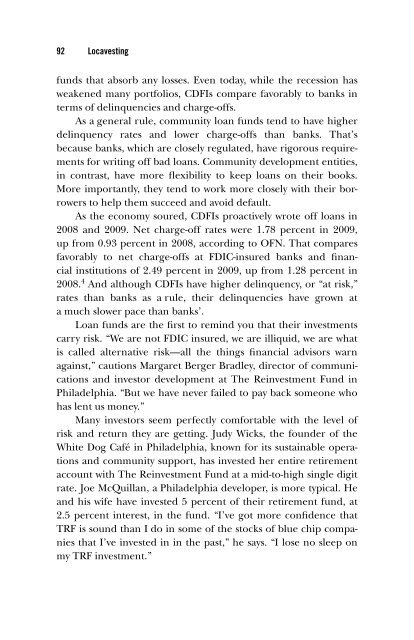3c hapter - Index of
3c hapter - Index of
3c hapter - Index of
Create successful ePaper yourself
Turn your PDF publications into a flip-book with our unique Google optimized e-Paper software.
92 Locavesting<br />
funds that absorb any losses. Even today, while the recession has<br />
weakened many portfolios, CDFIs compare favorably to banks in<br />
terms <strong>of</strong> delinquencies and charge- <strong>of</strong>fs.<br />
As a general rule, community loan funds tend to have higher<br />
delinquency rates and lower charge- <strong>of</strong>fs than banks. That’s<br />
because banks, which are closely regulated, have rigorous requirements<br />
for writing <strong>of</strong>f bad loans. Community development entities,<br />
in contrast, have more fl exibility to keep loans on their books.<br />
More importantly, they tend to work more closely with their borrowers<br />
to help them succeed and avoid default.<br />
As the economy soured, CDFIs proactively wrote <strong>of</strong>f loans in<br />
2008 and 2009. Net charge- <strong>of</strong>f rates were 1.78 percent in 2009,<br />
up from 0.93 percent in 2008, according to OFN. That compares<br />
favorably to net charge- <strong>of</strong>fs at FDIC- insured banks and fi nancial<br />
institutions <strong>of</strong> 2.49 percent in 2009, up from 1.28 percent in<br />
2008. 4 And although CDFIs have higher delinquency, or “at risk,”<br />
rates than banks as a rule, their delinquencies have grown at<br />
a much slower pace than banks’.<br />
Loan funds are the fi rst to remind you that their investments<br />
carry risk. “We are not FDIC insured, we are illiquid, we are what<br />
is called alternative risk—all the things fi nancial advisors warn<br />
against,” cautions Margaret Berger Bradley, director <strong>of</strong> communications<br />
and investor development at The Reinvestment Fund in<br />
Philadelphia. “But we have never failed to pay back someone who<br />
has lent us money.”<br />
Many investors seem perfectly comfortable with the level <strong>of</strong><br />
risk and return they are getting. Judy Wicks, the founder <strong>of</strong> the<br />
White Dog Café in Philadelphia, known for its sustainable operations<br />
and community support, has invested her entire retirement<br />
account with The Reinvestment Fund at a mid- to- high single digit<br />
rate. Joe McQuillan, a Philadelphia developer, is more typical. He<br />
and his wife have invested 5 percent <strong>of</strong> their retirement fund, at<br />
2.5 percent interest, in the fund. “I’ve got more confi dence that<br />
TRF is sound than I do in some <strong>of</strong> the stocks <strong>of</strong> blue chip companies<br />
that I’ve invested in in the past,” he says. “I lose no sleep on<br />
my TRF investment.”
















